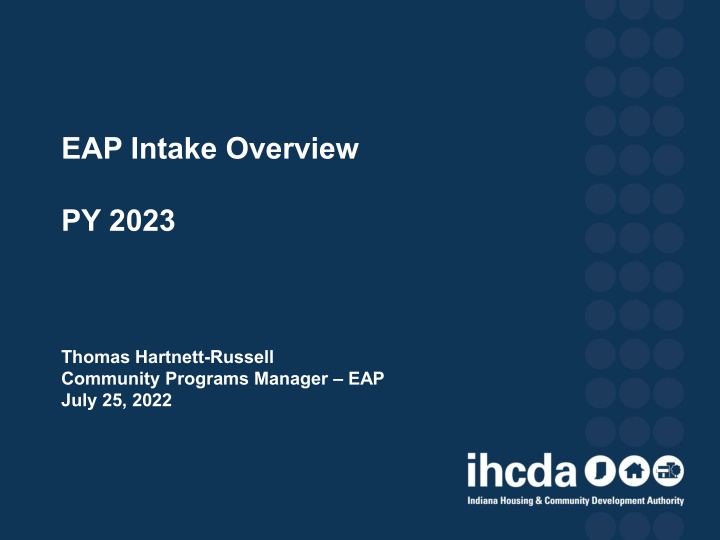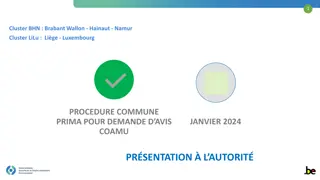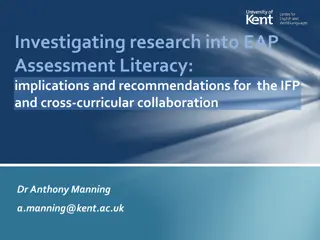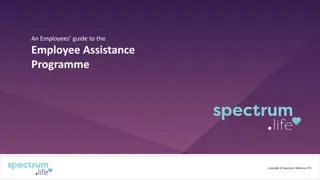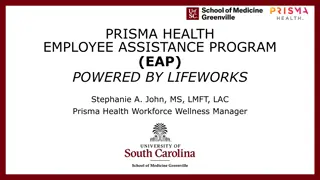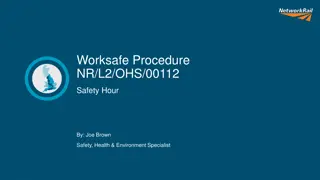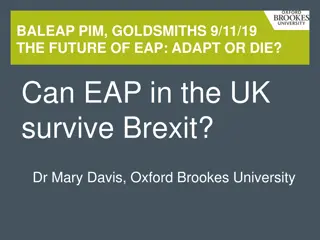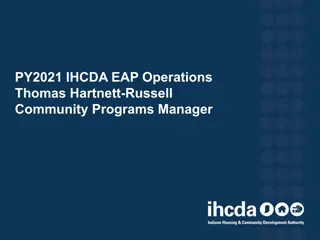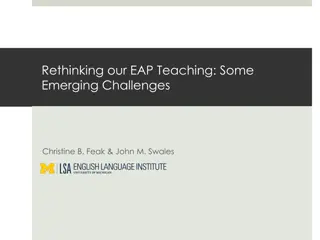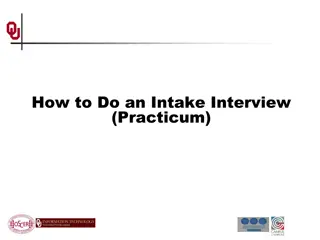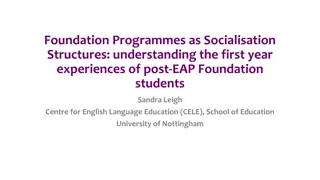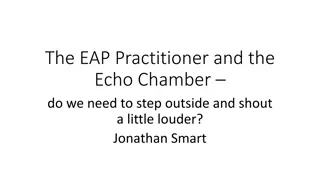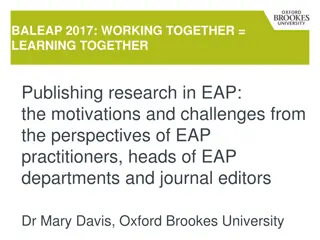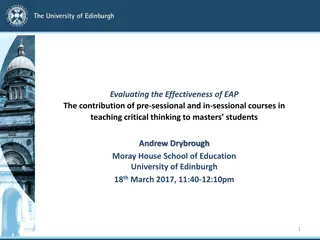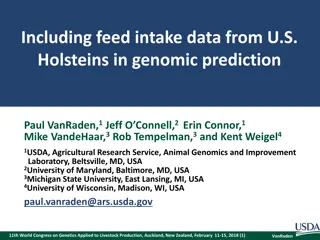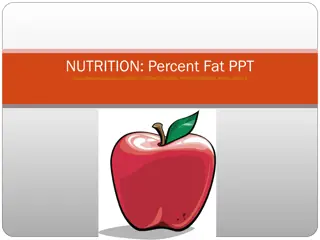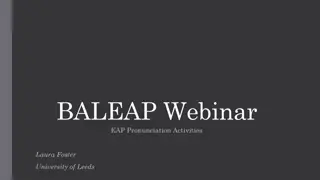Effective Intake Procedure for EAP Applications
This overview outlines the key steps involved in the intake process for EAP applications, including documentation review, household and benefit eligibility assessment. It also emphasizes the importance of completing the application accurately and providing necessary identity documentation. The thorough guidelines ensure a smooth intake process for applicants seeking assistance.
Uploaded on Feb 20, 2025 | 0 Views
Download Presentation

Please find below an Image/Link to download the presentation.
The content on the website is provided AS IS for your information and personal use only. It may not be sold, licensed, or shared on other websites without obtaining consent from the author.If you encounter any issues during the download, it is possible that the publisher has removed the file from their server.
You are allowed to download the files provided on this website for personal or commercial use, subject to the condition that they are used lawfully. All files are the property of their respective owners.
The content on the website is provided AS IS for your information and personal use only. It may not be sold, licensed, or shared on other websites without obtaining consent from the author.
E N D
Presentation Transcript
EAP Intake Overview PY 2023 Thomas Hartnett-Russell Community Programs Manager EAP July 25, 2022
AGENDA Intake Overview Common Errors Communication with Applicants Best Practices
INTAKE OVERVIEW Generally speaking, intake consists of the following major steps: Documentation Review Household Eligibility Review Benefit Eligibility Review
DOCUMENTATION OVERVIEW Intake reviews the application documentation to ensure that all required documentation has been submitted as part of the application: Fully completed and signed application Photo ID for HOH submitting application on behalf of household Proof of SSN for all household members over 1 year old Income documentation for all adult household members Utility billing statements Any other documentation needed based on specific household circumstances
APPLICATION The application form must be fully completed and signed by a household member age 18 or over. The application may not be signed by a non-household member unless the signing party has power of attorney for a household member. If the signing household member is not an adult, or if an online application is submitted with a minor listed as the HOH/applicant of record, the household must submit a new application. If the application is not fully completed, the intake must obtain the missing information. Intake may return the application to the applicant with an incomplete letter instructing them which fields must be completed. Intake may also confirm the information telephonically, through e-mail, or through a face-to-face conversation. The conversation must be documented in case notes or, in the case of e-mail, the discussion thread may be uploaded to the application documents.
IDENTITY DOCUMENTATION In order to confirm identity of household members, the following documentation is required: State-issued or federally-issued photo ID for the HOH submitting the application. Social Security Number verification for all household members age 1 year or above.
IDENTITY DOCUMENTATION Photo ID and SSN verification may be pulled forward from previous year applications if the household has previously applied in the LSP s territory. If any household member is unable or declines to provide SSN verification, the household member may be counted as an ineligible household member. However, the household must be given the opportunity to provide this documentation before processing the household with ineligible members. In order for a household to qualify, there must be at least one eligible household member in the dwelling. The eligible household member may be a minor as long as the application is being submitted by and signed by an adult.
INCOME DOCUMENTATION Income documentation is required for all adults in the household, as well as any benefits received by adult payees on behalf of children in the household. Documentation of earned or unearned income (may include bank statement for fixed income benefit payments only) Income Verification Affidavit (IVA) Printout of Uplink records for unemployment, or fully completed Department of Workforce Development Last Known Employer request Completed request for earnings statement
INCOME DOCUMENTATION Note that in general, we count gross income, not net income. This must be kept in mind when giving applicants guidance on completing an IVA. Applicants may not redact or alter the income documentation they provide (e.g., an applicant who receives SS income and provides a bank statement may not black out other lines on the bank statement). If the applicant does not wish to provide an unexpurgated bank statement, they may provide an SSA benefit letter. If an applicant provides an Uplink printout or an SSA benefit letter, the entire document is required. For example, partial screenshots of the Uplink statement may not be provided; the applicant must download and provide a PDF of their history. If an SSA letter is submitted that says page 1 of 3, the other two pages must be requested.
UTILITY DOCUMENTATION For regulated utilities (metered electric, metered natural gas, prepaid electric), the most recent/current account billing statement as of the date of application is required. The billing statement must include the following information: Vendor name Customer billing name Service address (this may be different from the billing address and must be specified) Account number Breakdown of usage/charges
UTILITY DOCUMENTATION For unregulated utilities (bulk fuels), the most recent/current account billing statement is required if the vendor provides account statements. Otherwise, the most recent delivery receipt may be accepted. The billing statement or delivery receipt must include the following information: Vendor name Customer billing name Delivery address (this may be different from the billing address and must be specified) Account number
UTILITY DOCUMENTATION All documentation must be complete. For instance, payment return coupons not accompanied by the full statement or only the front page of a multi-page bill is not considered acceptable. Nor is a screenshot of a customer s overall account status. All account details must be available to be reviewed and evaluated, including delivery/service address, services provided, and usage/charges. If the utility is in the name of a non-household member, a utility affidavit is required along with the account statement.
OTHER DOCUMENTATION Other documentation may be required depending on the household circumstances. These may include, but are not necessarily limited to: Utility affidavit Absent Household Member Affidavit Proof of homeownership and ERR Consent form Proof of disability if a household member claims they are disabled but does not receive an SSA-administered benefit Proof of military service Landlord Affidavit if utilities are included in rent Direct Benefit Payment form if utilities are included in rent
HOUSEHOLD ELIGIBILITY REVIEW When conducting the household eligibility review, intake is to consider only those factors that contribute to eligibility for the program: Indiana residency Dwelling characteristics Household composition Household income If any documentation related to this information is missing and is preventing intake from being able to accurately determine eligibility, the application is to be considered Incomplete, and an Incomplete Letter is to be sent to the applicant. If information is missing but it is not the applicant s responsibility to provide it (e.g., applicant provided a DWD LKE request and intake is waiting on DWD to return the results), the application is to be placed in In Progress status rather than Incomplete.
BENEFIT ELIGIBILITY REVIEW Once Household Eligibility has been determined and the household has been Approved, intake may begin to determine benefit eligibility. For the eligibility review, intake will require: Utility information (billing statements/account information) At-risk/vulnerable population documentation, if applicable Benefit eligibility review is to be conducted upon household eligibility approval. If at-risk/vulnerable population documentation is requested from the applicant, intake shall note the date the request was made to explain why benefit eligibility review is being delayed and note the date the documentation is due. If the applicant fails to return the documentation by this date, intake shall proceed with benefit eligibility determination without awarding at-risk status.
BENEFIT ELIGIBILITY REVIEW Note that our MOA with vendors requires that they cooperate with LSPs and IHCDA by providing customer information upon request. This includes billing statements. If an applicant does not turn in a billing statement for one or more of their utilities, intake is not to mark the application as incomplete, nor are they to send an incomplete letter to the applicant requiring them to submit the information. Instead, intake is to contact the utility vendor in order to request a copy of the account statement as of the application date. If the applicant does not turn in the correct billing statement (e.g., the billing statement provided is from two months prior to the application), intake shall request the appropriate billing statement from the vendor. In most cases, IHCDA expects benefit eligibility review to be completed, and claims added to approved applications, at the time of approval determination. In cases where additional information is needed, IHCDA expects that the claims will be added within 14 days at most from the date of approval.
COMMON ERRORS Intake should be aware of the following common errors that IHCDA has observed: Conflating Household Eligibility determination with Benefit Eligibility determination (e.g., marking household incomplete for utility bills) Denying households for failure to turn in SSN verification when the documentation exists in previous year s application file Failing to deny an application when documentation is not received after the due date on the incomplete letter has elapsed Denying an application for failure to submit utility bills or for outstanding utility deposits or excessive account credit balances
COMMON ERRORS Intake should be aware of the following common errors that IHCDA has observed: Failure to follow up with a household to determine if a member marked as disabled but who does not receive an SSA-administered benefit has documentation that they meet our definition of disabled Using incomplete or inappropriate income or utility documentation Denying a household for failure to turn in SSN verification for a household member rather than counting the household member as ineligible Marking an application as Incomplete when waiting on information from a vendor or DWD
APPLICANT COMMUNICATIONS Upon determination that an application is Incomplete, intake is required to provide written notification to the household of their status, what is needed, how to submit the required information to the LSP, and the date the documentation is due. The LSP is to notify applicants of this by using the incomplete application notification letter generated by the statewide database. This letter may be mailed by postal mail or, if the applicant provided an e-mail address and opted in to e- mail notification, it may be e-mailed. The notification letter may be supplemented by a phone call or a system notification in the statewide database, but these notifications may not replace the official notification letter.
APPLICANT COMMUNICATIONS Upon determination that an application is Approved, and after benefit determination has been completed and claims entered into the statewide database, intake is required to provide written notification to the household of their status and benefit levels. The LSP is to notify applicants of this by using the approval application notification letter generated by the statewide database. This letter may be mailed by postal mail or, if the applicant provided an e-mail address and opted in to e- mail notification, it may be e-mailed. The notification letter may be supplemented by a phone call or a system notification in the statewide database, but these notifications may not replace the official notification letter.
APPLICANT COMMUNICATIONS Upon determination that an application is Denied, intake is required to provide written notification to the household of their status and appeal and reapplication information. The intake is to notify applicants of this by using the approval application notification letter generated by the statewide database. This letter may be mailed by postal mail or, if the applicant provided an e-mail address and opted in to e- mail notification, it may be e-mailed. The notification letter may be supplemented by a phone call or a system notification in the statewide database, but these notifications may not replace the official notification letter. Intake must accurately record the denial reason in the statewide database for tracking purposes.
APPLICANT COMMUNICATIONS Note that the LSP is to be the primary point of contact with the applicant. Therefore, intake is not to direct applicants to call IHCDA directly concerning their application or their benefits. The LSP shall attempt to address the applicant s issues. If escalation to IHCDA is necessary, that escalation shall be made by intake or the LSP EAP Manager.
BEST PRACTICES LSPs should consider an internal tracking system to ensure that they track incomplete applications, receipt of missing documents, and timely denial of applications in which the applicant fails to return documents, as well as applications in which DWD or vendor information is requested. Ensure that applicants have easy access to multiple methods of turning in documents. Minimally, all communications should ensure that the LSP mailing address and phone number are included. An e-mail address is strongly recommended. LSPs may also wish to include a fax number. Rather than getting into specifics with applicants concerning timeframes, use the guidelines. For instance, if an applicant wishes to know when their eligibility will be determined, refer to their application date and the 55-day guideline. If an applicant is asking about receipt of their direct benefit payment, refer to their approval date and the 120-day timeline disclosed on their approval letter.
BEST PRACTICES Rather than getting into specifics with applicants concerning timeframes, use the guidelines. For instance, if an applicant wishes to know when their eligibility will be determined, refer to their application date and the 55-day guideline. If an applicant is asking about receipt of their direct benefit payment, refer to their approval date and the 120-day timeline disclosed on their approval letter. When sending an incomplete letter to an applicant, be sure to review all documents and fully determine everything that is missing. This will avoid having to send multiple incomplete letters to the household and will lead to a more efficient eligibility review. Always accurately track the application status.
BEST PRACTICES If in doubt, please feel free to reach out to IHCDA. As a general rule of thumb, whenever intake has to put their hands on an application, a case note should be left. This ensures that fellow intake staff, EAP manager, IHCDA, and, if necessary, federal HHS staff can feel confident that they have full context on the circumstances of an applicant s case.
